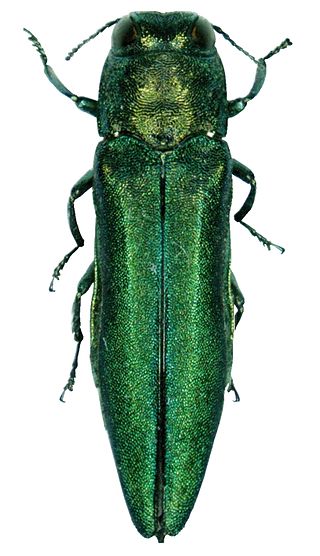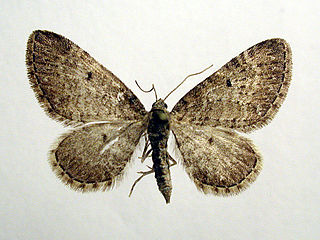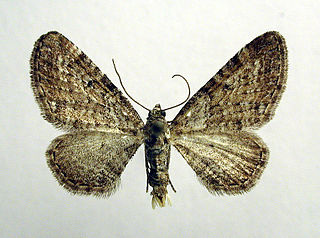
The emerald ash borer, also known by the acronym EAB, is a green buprestid or jewel beetle native to north-eastern Asia that feeds on ash species. Females lay eggs in bark crevices on ash trees, and larvae feed underneath the bark of ash trees to emerge as adults in one to two years. In its native range, it is typically found at low densities and does not cause significant damage to trees native to the area. Outside its native range, it is an invasive species and is highly destructive to ash trees native to Europe and North America. Before it was found in North America, very little was known about emerald ash borer in its native range; this has resulted in much of the research on its biology being focused in North America. Local governments in North America are attempting to control it by monitoring its spread, diversifying tree species, and through the use of insecticides and biological control.

Eupithecia is the largest genus of moths of the family Geometridae, and the namesake and type genus of tribe Eupitheciini. Species in the genus are, like those of other genera in the tribe, commonly known as pugs. The genus is highly speciose, with over 1400 species, and members of the genus are present in most of the world with exception of Australasia. Roughly a quarter of described Eupithecia species occur in the Neotropical realm, where they have an especially high species diversity in the montane rain forests of the Andes. The genus includes a few agricultural pest species, such as the currant pug moth, Eupithecia assimilata, which is a pest on hops, and the cloaked pug moth, Eupithecia abietaria, which is a cone pest in spruce seed orchards.

The juniper pug or juniper looper is a moth of the family Geometridae. The species was first described by Michael Denis and Ignaz Schiffermüller in 1775. It is found throughout the Palearctic and in the Nearctic.

Eupithecia satyrata, the satyr pug, is a species of moth of the family Geometridae. It was described by Jacob Hübner in 1813. It is found from Ireland, through northern and central Europe east to all of Russia and central Asia and western Siberia to Tibet. It is also present in North Africa and North America.

Eupithecia pernotata, or Guenée's pug, is a moth of the family Geometridae. The species was first described by Achille Guenée in 1857. It is known from the Alps, through Romania to southern Russia. It is also found in Finland.
Scopula planipennis is a moth of the family Geometridae. It is found in Sierra Leone.

Eupithecia subbrunneata is a moth in the family Geometridae. It is found in China and Russia.
Eupithecia duena is a moth in the family Geometridae. It is found in Ecuador and Peru.
Eupithecia infimbriata is a moth in the family Geometridae. It is found in Peru.
Eupithecia interrubrescens is a moth in the family Geometridae. It is found in Tibet.
Eupithecia irambata is a moth in the family Geometridae. It is found in India (Sikkim).
Eupithecia junctifascia is a moth in the family Geometridae. It is found in Colombia and Costa Rica.
Eupithecia lacteolata is a moth in the family Geometridae. It is found in Russia and Turkey.
Eupithecia leucographata is a moth in the family Geometridae. It is found in Mexico.
Eupithecia mediobrunnea is a moth in the family Geometridae. It is found in Mexico.
Eupithecia mejala is a moth in the family Geometridae. It is found in Ecuador, Bolivia and Peru.
Eupithecia muscula is a moth in the family Geometridae. It is found in Mexico.
Eupithecia pilosa is a moth in the family Geometridae. It is found in Costa Rica.
Eupithecia undulataria is a moth in the family Geometridae. It is found in Libya.
Eupithecia virescens is a moth in the family Geometridae. It is found in Brazil.





